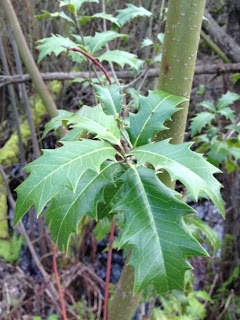Weather: Partly cloudy (dark rain clouds) with sun breaks and some blue sky
Temperature: ~50 degrees F
Time: 6:30 to 7:30 pm
Location: Marsh Island, Washington Park Arboretum
My observation site is located at Marsh Island- a small, soggy island in Union Bay that is connected by walking bridges to the rest of the Arboretum. I rode my bike from the University of Washington campus to the Arboretum, and kept exploring to find a spot near the water and with adequate vegetation. The walking path has many benches and navigates both sides of the island for snippets of waterfront observation. Based on the map below, it seems to be the meeting point of the Arboretum Waterfront Trail and the Foster Island Trail. My plan is to use this tiny island as an observation point in itself, and to spend time in one spot consistently while identifying species over the entire landscape. I don't know very much about Marsh Island, but I plan to go to the Visitor's Center and inquire about its history.
I am still unsure if this will be an adequate location for the high volume of species identification I plan to do. The island was very wet, and the path muddy. There was marshy area essentially everywhere except the designated path. Another inch of lake water and it would sink! There were plenty of shrubs, a few tall trees, and a bounty of singing birds. I was fortunate enough to catch a glimpse of a Great Blue Heron while walking, but could not capture a photo. It was standing near a small dock on the south side of the island, and as I approached, it took flight and flew east over the water with outstretched wings.
After walking the length of the island, I retraced my steps to post #13 for my observation spot. Note: the trail is marked with wooden number signs, perhaps indicating a species or lookout point? I need to inquire.
The air was warmer than it had been for weeks, and I was grateful to find a peaceful spot for the spring. I predict that much will change at Marsh Island over the next few months, and it will be exciting to observe those ecosystem interactions. The overall vantage point (essentially 50 meters from my sit-spot) was Union Bay. The stadium and the Montlake cut were clearly in view when looking NW. Behind me was an inlet bordered by the 520 bridge and more Arboretum Park land. In the immediate vicinity, there were countless fallen branches and scrubby shrubs that were challenging to distinguish. I could hear many kinds of bird calls. There is an incredible amount of moss, and what I perceive to be invasive species such as Himalayan Blackberry and Ivy (yet to be identified).
 |
| These were two forms of holly (or a prickly shrub) that I was unable to identify. |
 |
| Black Cottonwood (Populus balsamifera trichocarpa) |
The other species that intrigued me immediately was a small fern growing in the marshy area near the trail. I believe that the identification of Bracken Fern is correct -- using the information found in my field guide: "Field Guide to the Cascades and Olympics."
 |
| Bracken Fern (Pteridium aquilinum) |






No comments:
Post a Comment